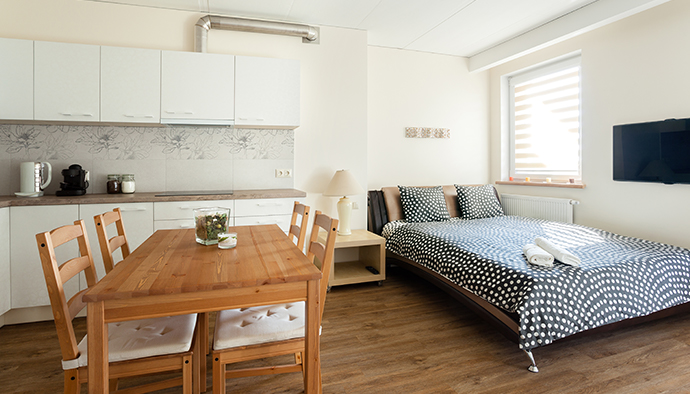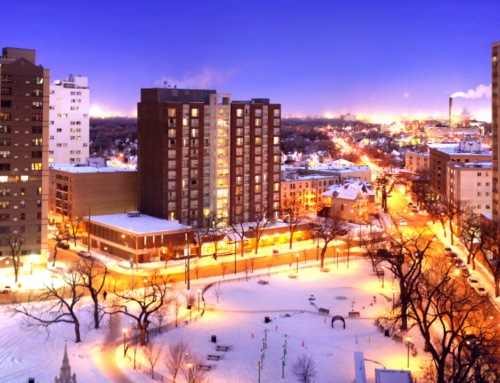If the tiny house craze has piqued your interest, but you don’t want to leave the city, you might be intrigued by the micro-condo concept. With more and more Canadians facing housing challenges both for reluctant renters and hopeful buyers, finding innovative housing solutions has a lot more people thinking inside the box.
Shoebox housing, also known as the micro-condo, is taking over as buyers and renters alike realize spacious living is no longer a reality for their incomes. The combination of unaffordable housing in hand with more and more people looking for ways to reduce their carbon footprint has led to a new generation of homeowners who are interested in micro-condos.
Here, we take a look at the micro-condo craze to help you decide whether or not it is something you should consider.
What is a Micro Condo Anyway?
name is kind of self-explanatory. The micro-condo is the smallest space you can imagine. We’re talking under 600 square feet, and for the truly dedicated, it’s often under 300. Despite their tiny footprint, the micro-condo is being designed to cleverly disguise small spaces to appear spacious and bright, while making the most of the limited area. This often includes expansive floor to ceiling use in the living space.
In cities like Toronto, the micro-condo can be found in some of the hippest areas like Liberty Village, St. Lawrence, and King West. These tiny homes can be under 300 square feet yet provide all the comforts, without any of the headaches and hefty price tags. For those with an eco-friendly, budget-conscious mindset, the benefits of micro-condos far outweigh the sacrifices.
Change in Housing Strategies
According to a new report from Ryerson University’s City Building Institute, major cities around the world are exploring ways to provide affordable housing for both renters and buyers. These cities include London, New York City, Vancouver, Seattle, and San Francisco.
A major contributor to these innovations includes the micro-condo as well as “unbundling amenities” provided by and included in condo prices. One developer is even offering the option to buy condos in “lots” based on customized sizes. These new housing strategies will help make homes more affordable in major cities.
The report shows that micro-units below 350 square feet have become very popular in urban centres including New York City and Seattle. Despite the fact that the rent and sales prices of these units are reflected in the unusually limited unit size, they appeal to city dwellers who are tired of spending most of their income to pay their mortgage or rent.
Smart House Condos
The micro-condo also allows builders to offer more units in centralized urban locations. Not only does it provide affordable living, but perhaps more importantly affordable living in highly desirable areas. Toronto developer Urban Capital built the first Canadian micro-condo on Queen Street West with the smallest unit just a mere 289 square feet.
The 25-storey condo at Queen and Simcoe offered micro-condos ranging in size from 289 square feet to a luxurious 380 square feet. The building also offered some more traditional larger units, but it was the micro-units that gained the most attention.
Nothing about the tiny units deterred buyers, with all units quickly selling out. This is an homage to the micro-condo and proof the desire or even the need for smaller, more affordable units exists.
While many buyers have moved in to their micro-condos as their primary residence, many others decided to rent out their mini units. Starting at about $1600 per month, these tiny apartments are still affordable by Toronto standards.
The Tiny Life
If you can handle the small space, you still get everything you need. In the case of the Smart House Condos, genius space saving designs include features such as movable partition walls, retractable kitchen countertops, Murphy beds, and double-tiered closets.
You still have your kitchen, bathroom, and a place to lounge and sleep all in relative comfort. Think micro cozy.
The Sacrifices of Micro Condo Dwellers
What some might view as sacrifices might not be so bad for the micro-condo enthusiast. For example, if you love to entertain, the micro-condo is clearly a non-starter. With such limited space, there is room for you and not much else.
A consideration for the avid chef is the micro kitchen. Although you might be able to find a reasonable kitchen to feed your need for food, many micro-condo kitchens are no more than a tiny strip with miniature appliances and next-to-zero counter space.
If you are a toiletry obsessed groomer, your teeny tiny bathroom that some might liken to a porta-potty will make it difficult to indulge your need to preen and pamper.
Although some couples are doing well as micro-condo dwellers, most couples are more likely to squabble in such a confined space. Add to that the limited storage space, and the fashionista or shoe-obsessed can also cross the micro-condo off their list.
Not Necessarily Cheaper
One thing to keep in mind is that yes, you are paying less for the unit when you look at the final sales price. But no, you aren’t necessarily getting a deal. The main reason micro-condos are cheaper is that you have less square footage. So, when considering value, it’s best to work out the average square footage costs.
In the case of the Smart House Condo, the listed pre-construction price was $249,000. The average per square foot for condos in 2018 was $690, and the per square foot of the Smart House micro-condo was $861 based on the pre-construction price. In another example, a 559-square-foot unit sold for $451,000, for a per square foot price of $806.
According to Urban Nation, in Q1 of 2019, the average sold index price within all actively marketed projects was $779 per square foot, while unsold prices were $998. When looking at the hot spot of Downtown Toronto, asking prices reached a record average of $1,279 per square foot. Once all is said and done, the micro-condo might even cost more per square foot, depending on the location and features.
The bottom line: If you’re determined to live in the heart of it all, and the price tag is your only concern, then the micro-condo might very well be the ideal home for your needs.









